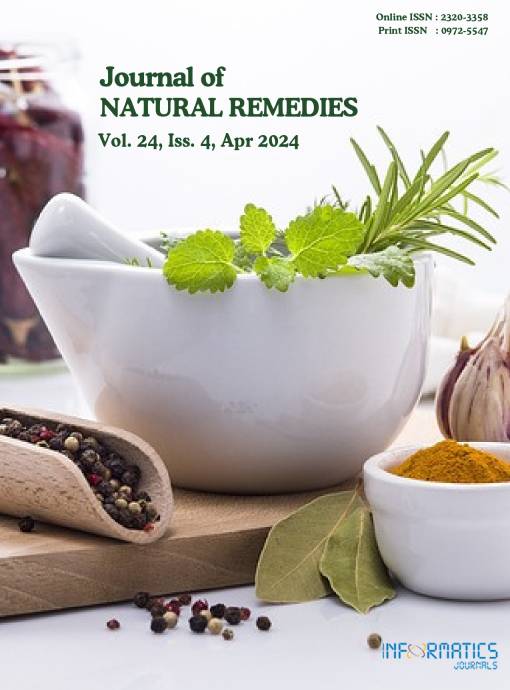Development and Evaluation of Polyherbal Hair Dye Formulation
DOI:
https://doi.org/10.18311/jnr/2024/34549Keywords:
Creams, Gels, Herbal Extracts, Herbal Hair Dye, Human HairAbstract
Background and objectives: Hair care products including hair dye play an important role in the maintenance and enhancement of appearance and overall wellbeing of the hair. Most of the hair dye available in the market contains harmful chemicals that may cause allergic reactions or irritation of the scalp. The objective of this study focuses on the formulation and evaluation of hair dye as creams and gels with different shades by using herbs. Methodology: The collected plants were authenticated, and shade dried. Then, extractions were done using water, ethanol, and methanol. Preliminary testing was conducted to obtain burgundy, brown and black by manipulating the ratios. Later, almond oil, coconut oil, beeswax and Carbopol-934 gel were added to ease the penetration. Finally, accelerated stability studies were done to check the physical and microbial stability of the product. Results: Eight different shades of hair dye were formulated in gel and cream form. Among them gel formulation F5 and F6 as well as the cream formulations F1, F2, F3, F4, F7 and F8 demonstrated good staining and better colour intensity. The accelerated stability studies of F1 to F8 revealed that there is no change in the physical evaluation and no evidence of microbial contamination. Conclusion: The output of this research is suitable for all races and age group because it is not a permanent hair dye that might have a restriction for some groups of races. As such, this hair dye is fully formulated with natural sources by considering in the reduction of severe side effects to the consumers.
Downloads
Metrics
Downloads
Published
How to Cite
Issue
Section
License
Copyright (c) 2024 Poonguzhali Subramanian, Anandarajagopal Kalusalingam, Deviga Kaliyappan, Fatin Natasha Binti Zaki, Pavitra Mohan, Pavitra Damoothran, Ng Jeck Fei, Abdullah Khan (Author)

This work is licensed under a Creative Commons Attribution 4.0 International License.
Accepted 2024-02-19
Published 2024-04-30
References
Madnani N, Khan K. Hair cosmetics. Indian J Dermatology Venereology Leprology. 2013; 79:654-67. https://doi.org/ 10.4103/0378-6323.116734 PMid:23974582
Sachan K, Kapoor VP. Optimization of extraction and dyeing conditions for traditional turmeric dye. Indian J Trad Knowledge. 2007; 6:270-8.
Rehman S, Khan SA, Sultana N, Ahmad S. Health risks of synthetic hair dyes: Advantages of natural hair dying agents in Unani medicine. J Trad Integrative Med. 2019. p. 37-46. https://doi.org/10.18502/tim.v4i1.1667
Da França SA, Dario MF, Esteves VB, Baby AR, Velasco MV. Types of hair dye and their mechanisms of action. Cosmetics. 2015; 2(2):110-26. https://doi.org/10.3390/ cosmetics2020110
Azwanida NN. A review on the extraction methods use in medicinal plants, principle, strength and limitation. J Medicinal Aromatic Plants. 2015; 4(3).
Louis D, Rashad A. Formulation of nano-sized dispersion from Calendula officinalis: A natural gateway to preparation of a hair dye. Research J Pharm Tech. 2023; 16(4):1815-22. https://doi.org/10.52711/0974-360X. 2023.00298
Shah S, Buraidah MH, Teo LP, Careem MA, Arof AK. Dye- sensitized solar cells with sequentially deposited anthocyanin and chlorophyll dye as sensitizers. J Optical Quantum Electronics. 2016; 48:1-8. https://doi.org/10.1007/s11082- 016-0492-3
Surya A, Deepan T, Alekhya V, Dhanaraju MD. A comparative study of dyeing efficiency and retention capacity of formulated polyherbal hair dye. Int J Recent Scientific Research. 2021; 12(9):43106-9.
Sridhara SU, Raju S, Gopalkrishna AH, Haragannavar VC, Latha D, Mirshad R. Hibiscus: A different hue in histopathology. J Medicine Radiology Pathology Surgery. 2016; 2(1):9-11. https://doi.org/10.15713/ins.jmrps.44
Kapoor VP, Katiyar K, Pushpangadan P, Singh N. Development of natural dye based sindoor. J Natural Products Radiance. 2008; 7(1); 22-9
Phadatare SP, Nesari TN, Deepak P, Pingle RP. Preparation, evaluation and hair dyeing activity of herbal hair oil and comparison with marketed dye. World J Pharm Research. 2015; 4(8):1469-78.
Morel OJ, Christie RM. Current trends in the chemistry of permanent hair dyeing. Chemical Reviews. 2011; 111(4):2537-61. https://doi.org/10.1021/cr1000145 PMid:21265503
Phadatare SP, Nesari TN, Pokharkar D, Pingle RP, Gadge MS. Comparative study of dyeing efficiency and retention capacity of herbal hair dyes. Int J Research Ayurveda Pharm. 2013; 4(2):198-202. https://doi.org/10.7897/2277- 4343.04221
Kumar KS, Begum A, Shashidhar B, Meenu M, Mahender C, Vamsi KS. Formulation and evaluation of 100% herbal hair dye. Inter J of Adv Research Med Pharm Sci. 2016; 2(1): 1-5.
Pal RS, Pal Y, Rai AK, Wal P, Wal A. Synthesis and evaluation of herbal based hair dye. The Open Dermat J. 2018; 12(1). https://doi.org/10.2174/1874372201812010090
Verma N, Mehra DS, Niyogi UK, Khandal RK. Retention of colour intensity in henna paste during storage. Nat Prod Radiance. 2008; 7(2):117-2.
Bhuvaneswari SS, Prabha T, Begum SS, Sivakumar T, Saranraj P, Manivannan V, Kumar BA. Formulation and evaluation, comparison of herbal hair dye with marketed formulation. Annals Phytomed. 2021; 10(2):175-81. https:// doi.org/10.21276/ap.2021.10.2.24

 Poonguzhali Subramanian
Poonguzhali Subramanian









 0.35
0.35 24
24 0.161
0.161